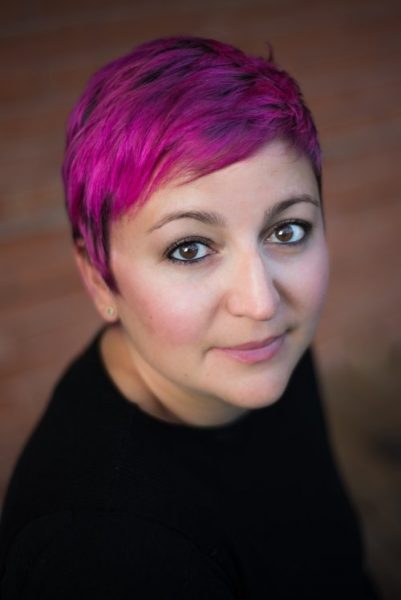
10 Feb TAB 2019: Event Overview & History
The 2019 Telluride AIDS Benefit begins Thursday, February 21, 6-9 p.m. with the Student Fashion Show at Telluride’s Palm Theater and ends on March 4 with the ever-popular Designer Sample Sale.
Scroll down for an event overview.
Volunteers are still needed to support the cause. Go here if you are interested in helping out.
Can’t attend? Donate here to help “Fight. Fund. Educate.”
For all tickets, go here.

HIV/AIDS: A brief overview

TAB’s muse, Robert Presley, strutting his stuff at fashion show in 1997 just before he succumbed to AIDS.
On June 5, 1981, the U.S. Centers for Disease Control and Prevention put out a report about “five young, previously healthy, gay men in Los Angeles” suffering from strange infections that had already killed two of them.
Throughout that summer, doctors across the United States trumpeted similar cases of “GRID” (Gay-Related Immune Deficiency). The New York Times went on to talk about a “deadly cancer” affecting about 40 gay men in New York and California.
The next year, the CDC named the new plague “AIDS” and gay men in San Francisco and New York City began the first community-based efforts to eradicate its cause, human immunodeficiency virus or HIV. At the time, condoms were the only reliable defense.
With a swiftness that imitates the spread of the disease, AIDS became enmeshed in the fabric of our society. Over the nearly four decades since AIDS reared its ugly head, the virus has killed millions of people and continues to infect millions worldwide each year. Globally, according According to Pathfinder International, HIV remains one of the most serious global health threats of our time. In 2017 alone, 1.8 million people were infected with HIV; 940,000 died of AIDS-related causes.
According to the Centers for Disease Control and Prevention, in the U.S. alone, while the annual number of new HIV diagnoses remained stable between 2012 and 2016, in 2017 about 40,000 people received a diagnosis not HIV.
In Colorado, today there are over 12,000 people living with HIV and AIDS; 32% of new HIV diagnoses are among young people ages 20-29.
And the cost of care for one person living with HIV is $3,500 per month and $42,000 per year.
It’s not over ’til it’s over. Which is why the Telluride AIDS Benefit keeps on keeping on.
Telluride AIDS Benefit: A thumbnail history

From the get-go, AIDS victims and their families flocked like moths to flames of hope – a miracle cure whispered here; a sudden recovery talked about there. The pot of gold everyone is seeking at the end of the rainbow is a vaccine, but so far, nada – though good progress is being made.(See more on that below.)
At the same time, as people have watched friends cut down in the prime of life, they have tried to make sense of the scourge by channeling their experience into ways to help. The Telluride AIDS Benefit evolved from that impetus.
In 1994, the fledgling event was all about helping a local and friend, Robert Presley, battle the disease and pay his mounting medical bills. But what Presley wanted was to help others who faced with the same challenges he was facing.
Robert Presley died in 1997 from causes related to HIV/AIDs, but his selfless wish came true: the nonprofit he inspired, TAB, helps individuals and families dealing with HIV/AIDS on the Front Range all the way to sub-Saharan Africa through a growing list of beneficiaries. They all use these discretionary funds to support AIDS services for individuals and families alike.
TAB beneficiaries include the Western Colorado AIDS Project in Grand Junction; Children’s Hospital Immunodeficiency Program in Denver; Brother Jeff’s Community Health Initiative in Denver; The Collaborative Care Clinic at St. Mary’s in Grand Junction; The Red Ribbon Project in Vail; The Moab Free Health Clinic in Moab, Utah; The Ethiopian Family Fund in Addis Ababa; and the Manzini Youth Care in Manzini, Swaziland.
For more on TAB’s beneficiaries, go here.
And Ron Gilmer, Presley’s former partner and TAB board member, continues speaks for Presley.
Gilmer keeps the fight alive by reminding us why we need to continue to support TAB. And why TAB needs to continue to remain focussed on patient care, prevention and education and stays laser-focused on its mission to “Fight. Fund. Educate.”

Ron Gilmer with Robert Presley way back when. Gilmer remains an AIDS activist & TAB board member.
To that end, every year Gilmer gets up on his soapbox and argues that prevention is the name of the game if the goal is to stop the spread of the pandemic. Which it is: TAB is working with its partner organizations towards the goal of ZERO new HIV infections in the state of Colorado by 2030 and believes that is attainable. Restrictive government guidelines that politicize the issue and focus on abstinence only are therefore, according to Gilmer, “tragically misguided.”
As stated above, from the get-go, TAB has helped fill some of the voids in public education and awareness. Because of its success in this arena, Gilmer has suggested TAB clones belong in every community in the world.
He is right.
TAB: Hope in a little blue tablet?

Dr. Myron Cohen, infectious disease specialist, a believer in Truvada or PrEP.
For some years now, doctors have treated the virus with a combination of powerful and effective drugs that keep the disease in check, a prime example being an an ovoid-shaped blue pill, brand name Truvada, which has been used for about a decade to treat HIV and was discovered to be variably effective in preventing HIV-negative people from contracting the virus.
Truvada is now indicated (in combination with safer sex practices) for pre-exposure prophylaxis or PrEp to reduce the risk of sexually acquired HIV-1 infections in adults at high risk.
Again, PrEP is a way for people who do not have HIV, but who are at substantial risk of getting the disease, to prevent HIV infection by taking a pill every single day. Truvada contains two medicines (tenofovir and emtricitabine) that are used in combination with other medicines to treat HIV.
Truvada may be the hope du jour and at least a corner of blue sky in the dark world of HIV/AIDS, which twins with name Dr. Myron Cohen, a specialist in infectious disease. Dr. Cohen has been on the forefront of “treatment as prevention” for decades.
Not long after the first FDA-approved drug treatment for HIV/AIDS, AZT, appeared in 1987, Cohen began studying the effect of this and later drugs on the amount of virus in genital secretions. That work led to the idea that people taking these drugs might be less contagious.
In 2005, Cohen launched a clinical study, known as HPTN 052, in 1763 couples, where only one person was HIV-infected. The results indicated that early antiviral therapy reduced sexual transmission by at least a whopping 96 percent.
The then executive director of UNAIDS called Cohen’s findings a “game-changer.”
The Economist speculated on “The End of AIDS,” and “treatment as prevention” became a central part of global HIV/AIDS prevention strategy and a kind of mantra.
In December 2011, Science magazine, named “treatment as prevention” and Cohen’s HPTN 052 the scientific “Breakthrough of the Year.”
PrEp, antiretrovirals, over 15 million HIV-positive people worldwide now on treatment and AIDS-related deaths have declined, which is good news. So should we be stashing our red ribbons at the back of the drawer?
From the Centers for Disease Control and Prevention:
“Pre-exposure prophylaxis (or PrEP) is when people at very high risk for HIV take HIV medicines daily to lower their chances of getting infected. PrEP can stop HIV from taking hold and spreading throughout your body. It is highly effective for preventing HIV if used as prescribed, but it is much less effective when not taken consistently.
“Daily PrEP reduces the risk of getting HIV from sex by more than 90%. Among people who inject drugs, it reduces the risk by more than 70%. Your risk of getting HIV from sex can be even lower if you combine PrEP with condoms and other prevention methods.”
According to Sarah Gluckstern, the executive director of the Telluride AIDS Benefit, “PrEP is changing the dialogue around HIV and AIDS. Now that individuals can protect themselves BEFORE exposure, we should see a decline in overall infection rates. And PrEP has gone global – I recently saw an ad for the medication in Bangkok, Thailand!”
Go here to listen to our podcast with Dr. Myron Cohen. Though the interview took place three years ago, much of the information is still relevant today.
TAB: Event Overview

Every year, the Really Big Cultural Event of TAB week – and arguably of Telluride’s winter season – is the Telluride AIDS Benefit Gala Fashion Show. This year #26 takes place on Saturday, March 2.
According to TAB, the Gala Fashion Show is a show as unique as the region itself. With a 26-year local history, this is not your average runway march: the happening has been described as a “Broadway Pop-Up” and “Cirque de Soleil meets NY Fashion Week.” The all-volunteer cast and crew spare no expense to raise money for the cause. Tickets here.
The Sneak Peek Fashion Show & Live Auction, this year in February 28, features local models and international designer fashions. All proceeds from the event, a kind of dress rehearsal for the Main Event on March 2, benefits HIV and AIDS service organizations in Colorado, Utah and Africa. Tickets here.

Part of the fashion show includes the winner of TAB’s “Say It With A Condom” contest. “Runway Ready.” Diana Ries of Erin and Diana Ries Designs got the nod.

The list of designers on the catwalk this year, a mix of local and national brands, includes:
List of designers so far:
Loom Imports
Two Skirts
Lauren Wood
Spiritual Gangster
FUEL
Heritage (Mountain Village)
Head Regal
Mary Jane Swim
The Dig Rigg
Never a Wallflower
The North Face
Lela Rose
Andrew Marc
TOPO Designs
Corridor
Concrete + Water
Lily Guilder
Yalivta
Parke and Ronen
Rails
Fine Navajo Weaving
Pip’s
Down to Earth
Sublime
Jenni Kayne
Toad & Co
Jimmi Wz
Ricorso
Deitch PR
Sinesea Karol
New York Performance
TAB fashion show, a history:
When AIDS arrived on the scene almost 40 years ago it hit the fashion industry like a sledgehammer, decimating a broad spectrum of that universe: Among the famous names who died in the early dark days: Patrick Kelly, Angel Estrada, Isaia, Adrian Cartmell, Clovis Ruffin, Halston and Perry Ellis. Antonio Lopez and Juan Ramos, Tina Chow, Robert Rose, Peter Lester, Tim Hawkins, Sergio Galeotti, Robert Hayes and Laughlin Barker. But a full list of the famous, infamous, and mostly unknown who perished from the burgeoning epidemic would have required a compilation as thick as the New York telephone book.
Back then, AIDS was the equivalent of a medieval plague. It was a mystery at the black heart of which was one question: Who is next?
Back then, the pandemic was called Gay-Related Immune Deficiency (GRID) because national religious leaders such as Pat Buchanan and Jerry Falwell preached the virus was cosmic revenge on homosexuals for crimes against nature.
The local chapter of the story opens in 1993, when a group of friends inspired by mover-and-shaker Kandee DeGraw founded the Telluride AIDS Benefit to help a really good friend, who, yes, was gay, defray costly medical expenses associated with his battle against HIV/AIDS. The gala was the brainchild of DeGraw’s good friend Daiva Chesonis
Daiva Chesonis, founder, TAB’s fashion show, now owner of Between the Covers bookstore.
A fashion show to raise funds made sense then (and now) because TAB’s muse, the aforementioned Robert Presley, was an enfant terrible and gifted fabric artist, the life of the party and a one-man campaign for awareness education – because HIV/AIDS is 100 percent preventable either through total abstinence or, more realistically, through education and eyes open about safe practices regarding drug use and sexual activity.

Robert Presley as Sick Man Pretending He Is Not Sick, image (and title), Ingrid Lundahl
The first fashion show to raise funds to support Presley was held on the Opera House stage in 1994 and raised about $10,000.
“I make paintings in the form of garments,” Presley once told me.“My work allows people to literally step into the world of art, breaking the barrier between art and life.”
In February 1997, just a few months before his death, Presley fulfilled a lifelong fantasy. He donned a tiara and a Miss America-style sash and strutted down the TAB’s catwalk in a mint green ensemble with matching parasol. Bien sur. The crowds went wild for ‘Miss AIDS 1997.”
TAB’s fashion show continues to be a tribute to Presley and his flair for fashion fun and high drama. Lights, color, bold, unconventional, sometimes outrageous clothes, near-nudity, music, dance – in the words of one old friend, “an atom bomb of fanTABulousness” – conspire for the singular purpose of raising funds to support TAB’s beneficiaries.
Since 1994, largely through the Gala, TAB has managed to donate just under $3 million towards HIV/AIDS education, advocacy, clinical care, and NGOs.
All that because a very hardworking group of Telluride’s best, brightest and buffest know how to shake what their mamas gave them – and because they care.
Student Fashion Show: A history & Student Education Day:

Telluride High School student directors Macy Desmarais and Justus Tudor welcome everyone to an all-student production at the Palm Theater on Thursday, February 21, 6 p.m.
For years, educator Sandy McLaughlin headed TAB’s HIV/AIDS awareness and risk-reduction initiatives at the school even before TAB’s inception dating back to the time she was school principal, 1991 – 1994. Post-TAB, McLaughlin used educators from its primary beneficiaries as well as local health authorities to teach our kids the facts of HIV/AIDS life.
If she said it once, McLaughlin, a TAB board member, and now her heirs have said it a dozen times: though the Student Fashion Show marks the kickoff of TAB time in Telluride, and while the director of the show and her team are tasked with raising about money for the cause, the catwalk is not the primary reason TAB produces a Student Fashion Show.
In other words, read between the (clothing) lines.
For the Telluride AIDS Benefit, the big idea behind the clothes, the choreography, and the music is the fact the pandemic persists, largely unabated and increasingly among young people. The tenacity of the virus drives the need for prevention education to keep everyone safe and, yes, it too is about raising money to support the Telluride AIDS Benefit’s growing list of worthy beneficiaries through its spectacular fashion events.
And prevention education does not stop after the day of talks at the school during TAB week. It continues with the peer educators, a small army of crusading teens trained in AIDS advocacy to make a difference. A number of those peer educators, if not all, are also models in the Student Fashion Show.
This year, AIDS Education Day on February 28 at Ridgway High School; March 1at the Telluride High School.
Poet Madelyn Garner “Memories & Mimosas”:

Author Madelyn Garner featured at new TAB event.
This new event takes place March 3. For more about this light buffet, talk and book-signing for the authors :Hum of Our Blood,”go here.
Designer Sample Sale, March 4.
For more go here.
About TAB’s director, Sarah Gluckstern:

Sarah joins TAB as Executive Director following twenty years of experience in the HIV and AIDS field, including four years with the Telluride AIDS Benefit. In the 1990s, she watched as a close family friend valiantly battled AIDS; when he passed away in 1998, it inspired her to battle the disease in her own way, on whatever fronts she could.
Gluckstern holds Masters in Public Health from UC Berkeley. Her work took her to New York and San Francisco; spanning testing, counseling, educational outreach, work with clean-syringe exchange programs and global public policy research.
For more about Gluckstern, go here.
About TAB’s assistant director Jessica Galbo:

Jessica Galbo, center.
Jessica Galbo has served formerly as the TAB Fashion Show Director & Choreographer.
As an HIV test counselor in San Francisco at the Haight-Ashbury Free Medical Clinic, as well as an EMT working with travel clinics in Guatemala, Galbo has seen first-hand the effects of HIV and AIDS and is honored to continue working with TAB to combat this disease.
In addition to her work with TAB, Jessica Galbo is a traveling emcee for Mountainfilm,..
Katy Parnello and Jamie J are respectively the artistic director and choreographer of the Fashion Show. Their impressive bios are here.


Ron Gilmer
Posted at 10:30h, 11 FebruaryLooks good, lots of work obviously went into this story!
admin
Posted at 10:33h, 11 FebruaryThank you Ron. You and Robert were the angels on my shoulder when I put the piece together.